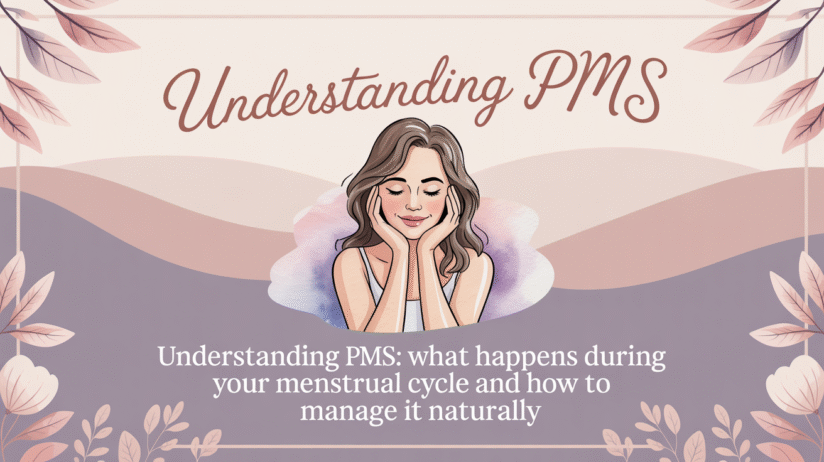Premenstrual syndrome (PMS) refers to a collection of emotional, physical, and behavioural symptoms that manifest in the one to two weeks leading up to menstruation. While nearly all women experience some premenstrual changes, about 20–25% experience moderate to severe symptoms that interfere with daily life. Around 5–8% may develop a more intense condition known as premenstrual dysphoric disorder (PMDD).
What Is PMS? Defining Premenstrual Syndrome
PMS is characterized by a predictable pattern of symptoms, emotional, behavioural, and physical, that begins after ovulation and resolves shortly after menstruation starts. Unlike normal period discomfort, PMS specifically interferes with personal, social, or occupational functioning.
PMS Symptoms: Emotional, Physical, and Behavioral
Emotional and Psychological Symptoms
- Mood swings, irritability, and anxiety
- Feelings of sadness or depression
- Emotional hypersensitivity or crying spells
- Tension and nervousness
- Loss of interest in daily activities
Physical Symptoms
- Breast tenderness and swelling
- Abdominal bloating or cramps
- Headaches or migraines
- Fatigue and low energy
- Joint or muscle pain
- Weight gain or fluid retention
Cognitive and Behavioural Changes
- Difficulty concentrating
- Insomnia or oversleeping
- Food cravings, especially for sweets or salty items
- Increased sensitivity to noise or light
PMDD is a more severe form of PMS and includes at least five intense symptoms that significantly affect daily functioning.
Cycle Timing: When PMS Begins and Ends
PMS symptoms typically begin during the luteal phase of the menstrual cycle, around 7 to 10 days before menstruation begins, and subside within a few days after menstruation starts. In some women, the symptoms tend to worsen in their late twenties to forties and often improve after menopause.
Causes of PMS: Hormonal Sensitivity and Brain Chemistry
The exact cause of PMS is not fully understood, but the most accepted theories include:
- Hormonal fluctuations – Women who are more sensitive to the normal hormonal changes after ovulation may experience PMS symptoms.
- Brain chemical changes – Alterations in serotonin and GABA levels may trigger mood-related symptoms such as depression, irritability, or fatigue.
Other possible contributing factors include genetic predisposition, underlying health conditions, stress, and lifestyle habits.
Diagnosing PMS: Tracking and Clinical Criteria
There’s no specific test to diagnose PMS. Diagnosis is based on a clear pattern of symptoms that occur consistently in the second half of the menstrual cycle and disappear with menstruation. To confirm PMS:
- Symptoms must be present for at least two consecutive menstrual cycles
- There must be a symptom-free phase during the first half of the cycle
- The symptoms must significantly affect quality of life
Keeping a symptom diary or using a menstrual tracking app can help distinguish PMS from other mental health or hormonal disorders.
Natural and Lifestyle Approaches to Manage PMS Symptoms
Diet, Nutrition & Herbal Supplements
A healthy, balanced diet can play a major role in reducing PMS symptoms. Recommendations include:
- Eating plenty of fruits, vegetables, whole grains, and lean proteins
- Reducing intake of refined sugar, salt, caffeine, and alcohol
- Staying hydrated and avoiding processed foods
Certain supplements have been found to help reduce PMS symptoms:
- Calcium – May reduce fatigue, cravings, and depression
- Magnesium – May relieve bloating and mood swings
- Vitamin B6 – Supports serotonin production
- Vitamin D – Helps regulate mood and hormonal balance
- Herbal remedies – Evening primrose oil, chasteberry, and chamomile may offer relief in some women
Always consult a healthcare professional before starting any supplement.
Regular Exercise & Stress Reduction
Exercise promotes endorphin release, which can improve mood and reduce pain. Activities such as:
- Brisk walking
- Aerobic workouts
- Resistance training
- Yoga and stretching
can significantly help manage PMS symptoms. Additionally, stress-reduction techniques like meditation, mindfulness, and deep breathing exercises improve emotional resilience and reduce irritability.
Self-Care and Emotional Support
- Prioritize sleep and maintain a regular sleep schedule
- Avoid overbooking your calendar during the premenstrual phase
- Spend time with loved ones and engage in activities you enjoy
- Practice journaling or creative hobbies to process emotions
Medical and Therapeutic Treatment Options
If PMS symptoms interfere with daily life, medical treatment options may be needed:
Over-the-Counter Remedies
- Non-steroidal anti-inflammatory drugs (NSAIDs) like ibuprofen for cramps and headaches
- Diuretics to reduce water retention and bloating (under medical guidance)
- Natural mood-supporting supplements like omega-3s or herbal teas
Prescription & Hormonal Therapies
- SSRIs (e.g., fluoxetine, sertraline) for emotional and psychological symptoms
- Hormonal birth control pills, particularly those containing drospirenone, to regulate hormone fluctuations
- Estrogen patches or GnRH agonists may be prescribed in severe cases, especially in PMDD
Alternative Therapies
Some women find relief through alternative treatments like:
- Acupuncture
- Massage therapy
- Aromatherapy
- Saffron capsules or other herbal treatments
These therapies may not work for everyone but are worth exploring under professional supervision.
Outlook: Living Well with PMS
While PMS is a recurring monthly experience for many, it can be effectively managed. Some women find that their symptoms stabilize over time, while others experience more severe phases. The key lies in identifying your individual triggers, making lifestyle adjustments, and seeking medical help when necessary.
After menopause, PMS symptoms typically subside. However, if symptoms are significantly affecting your quality of life, consult your gynaecologist for personalized treatment.
Conclusions: Empowering Yourself Against PMS
You don’t have to let PMS control your life. Here’s a summary of how to manage it naturally and effectively:
- Track your cycle to understand when symptoms begin
- Follow a balanced diet and take recommended supplements
- Engage in regular exercise and practice stress-relief techniques
- Seek professional help if symptoms become disruptive
Managing PMS is about balance, physically, mentally, and emotionally.
Consult an Expert
If you’re struggling with PMS or think you might have PMDD, schedule a consultation with Dr. Shweta Wazir for a complete evaluation and expert care.
📞 Call: +91 84481 28007
🌐 Visit: www.drshwetawazir.com


Leave A Comment